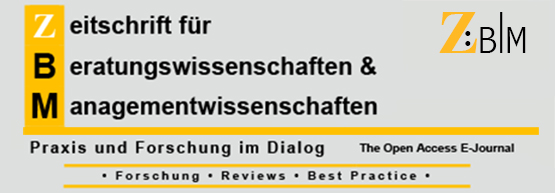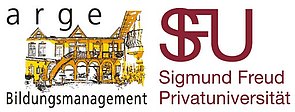
Zeitschrift für Beratungs- und Managementwissenschaften
Ausgabe 2018/01
ISSN 2312–5853
Full Text: ![]() Artikel als PDF
Artikel als PDF
Gerda Mehta 1 ◊
About peacetraining.eu *
The European Union, United Nations, World Bank, World Economic Forum and other leading think tanks and institutions across Europe and internationally have publicly recognised we are living in a time of:
- increase of systemic challenges to social, economic and political systems, and
- multiplicity of crises and conflicts characterised by complex dynamics which are not amiable to simplistic measures or solutions.
Failure of many current/conventional measures and policy responses to effectively prevent conflicts and crises or to effectively address and ameliorate the causes, drivers and conditions is giving rise to conflicts and crises (IPINST, 2003).1
During the past decade the CPPB (conflict prevention and peace building) training field has rapidly evolved as a result of the growing engagement of the European Union in the field of peacebuilding. This dynamic is both challenging and opportunity -arising. The PeaceTraining.eu initiative has reviewed current understandings and training approaches relating to conflict prevention and peacebuilding (CPPB) in Europe, has developed recommendations and novel tools for enhancing the potentials of European civilian, police and military training and in turn, has done that with the ambition and recognition of contributing to the efficiency of peacebuilding missions. And the result looks good – CPPB has shaped into an indigenous profession, with qualification, reputation, certificates and research of its own.
The PeaceTraining.eu online platform is the main outcome of this project. It is developed based on an extensive research process and responds to some of the major current challenges in the field of CPPB training. It is interactive: user-friendly modules include reliable information on training providers, individual trainers, and training courses in Europe. Moreover, it offers advice and tools for designing and implementing CPPB training through its online Handbook, as well as access to a resource directory on training in the field. Through offering of these tools and resources, the platform promotes innovation, effectiveness, and ultimately, the continued improvement and performance in CPPB training (see newsletter www.peacetraining.eu).
Why the ARGE has chosen this topic? Peace and peace negotiations were traditionally done by diplomates, church and outstanding persons like Solon in 6th century BC, Alvise Contarini in 17th century, or Fabio Chigi in similar times, as Duss von-Werdt already has elaborated in his “homo mediator”, Klett Cotta 2005. Perhaps harmony and building bridges between people to return to easiness and openness for living together is a deeply rooted tendency for community and has been ever since. Why one needs a professional training? In 21st century many aspects of the so called basic human conduct have reached professionalism - consultancy, personal assistance, social work, psychological advice, psychotherapy, mediation, clinical psychology and the like. Then, why not have professional assistance for peace building/keeping?
The on-line ARGE Forschungsjournal has dedicated this issue to peace training and associated fields, as we think peacetraining is an important educational element societies need for peaceful coexistence within society and with other societies. The platform with its easy, open access promotes knowledge of CPPB for everyone. In this way CPPB – competence becomes the chance to potentially reach everyone.
This open access online- journal can give a taste of it, starters of the extensive menu of the platform. The contributions give evidence: peace trainings have reached a level of differentiation that good practise can be defined:
- A common understanding has been reached how to help people and peoples, communities and societies to find back to ways of dealing with each other, debate and search for coexisting solutions and transformation.
- A European platform has been formed as an umbrella information source for training institutes, trainers and information about peace trainings.
- On the platform www.peacetraining.eu one can find a range of diverse approaches to peace training and peacebuilding and its applications, one can get insight in the movement to work towards peace and peace keeping for communities and individuals affected by conflict and war and in preventive work.
The issue offers insight in a broad variety of methods – all contributing differently to peaceful coexistence – before, in and after escalation. Peace is predominantly a matter of security, Berthold Hubegger from the Federal Ministry of the Interior – Bundesministerium für Inneres, Austria states. Helping the police to work properly and be accepted by the society contributes a major portion to stability within a country after immense turmoil. Clear regulations help increase safety measures.
The missions get their mandate, and the people going on mission need skills and professional training to deliver proper work, even in risky dynamics. Wilfried Graf´s and Galina Pokhmelkina´s contributions give us hints in the stony way towards dialogue and how fragile these processes remain and how easy it is to return to violence and hatred, no matter where in the process. One also can imagine, how exhausting these missions can get and what it takes to keep standing there as a lighting house.
On the other hand building trust within the individuals with the help of psychotherapeutic interventions after the loss of one´s own country, citizenship and often also family ties brings many people and their beloved to unacceptable limits – including also professionals, surroundings and the involved person him/herself. Sibylle Lebeth reflects on the helpers and their helping hands in that process.
Galina Pokhmelkina and Maxim Ieligulashvili describe from the Ukrainian and Russian perspective, while their countries are in turmoil / conflict; they were engaged in building platforms and imaginary bridges for the gaps and the silences, while weapons spoke in the open conflict regions. They show different approaches, how to (re)start dialogue, in direct dialogue forms and/or through art, as we say in Central Europe - many roads lead us to Rome!
While Maxim Ieligulashvili states the art approaches can open up for peace building, he reflects about its positive and negative impacts. Borislava Manojlovic describes the pedagogic reasoning for a special approach, as learning processes for reaching inner motivation have more success building on self experience and insights rather than objective information oriented teaching methods. – two very valuable contributions for understanding the novel approaches used nowadays in peace trainings.
While Roland Wilson`s article calls for a deeper understanding of the use of mediation and recognizing power games within societies, Wilfried Graf and Gudrun Kramer expand mediation approaches to a special way of narrating their inner motives and shared understandings of their reference groups and history. They emphasize the long, long roads towards peace and the many shades that help coming back and walking in that direction. According to Graf and Kramer, touching and respecting each other´s personal needs seems to be the golden road towards daring to dialogue again and often indicate a kind of breakthrough.
Galina Pokhmelkina explains the method “diapraxis” a way how to lead heated debates even in the times while armed conflicts are still virulent. She is convinced that many dialogues organized parallel to fights can prepare peace talks and make the societies be prepared to accept peace talks. “Diapraxis” becomes an important tool for minimizing further escalations within societies, even though it looks like little can be done.
Andrii Gusiev´s article helps us understand that no matter how the circumstances are in the country, there is a civil movement that is interested in dialogue. The mediation movement in Ukraine has managed to implement mediation as a professional tool and also develop its professional status within the last years- congratulations!
Anne Isabel Kraus and Tatiana Kyselova show us how one could conduct researching the dialogues in turmoil times, as we already have seen the research position of Kramer and Graf has shown to be a helpful further contribution for moving the involved parties see a wider picture of the situation they are trapped in.
And if one wants to go further in professionalizing his/her interest, Stela Shiroka has a fantastic collection of useful tools to improve one´s skills and knowledge, while also calling for the way the online tools should expand.
When CPPB training was first beginning in the 50s and 60s, training was normally developed by a single trainer or sometimes 2 to 3 trainers working in a team. Training ‘methods’ were often top-down and lecture based, as many ‘trainers’ themselves came principally from academic backgrounds. Today the role of trainers has evolved, diversified and, to a certain extent, professionalized. There are still many programmes characterized by ‘top down’ lecture-based presentation and delivery, but at the front of the field training methods are increasingly practical, experiential, operational, and are aimed to improve participants´ competencies for performance in the field. The role of those involved in ‘development’ and ‘design’ of training has also expanded. Today rather than just single trainers inputting from their experience and approach, entire training support teams exist (amongst larger training organisations), while consortia of organisations, universities, training institutions and other stakeholders are increasingly collaborating to improve the quality of curricula, approaches and methodologies for CPPB training.
Ever since the beginning of the intentional provision of conflict prevention and peacebuilding training, the field has experienced an evolution with respect to the different formulae of training and training infrastructure. An important step in this evolution, as identified above, has been the creation in many training centres and staff colleagues of Training Units or Departments.
The issue is a small bite of what you can get in the www.peacetraining.eu platform: a platform that unites the peace training institutes, peace trainers and gives a lot of information for professional peace training standards. It has much information on helping peace processes and sustainable interest in each other and tolerance for each other. It has been the product of a two-year Horizon 2020 project, with the intention to form an overview and a shaping of the European Way of Peace Training. The consortium members believe, they have reached the goal.
Vienna, May 2018
Gerda Mehta
Consortium member of peacetraining.eu
1https://www.ipinst.org/wp-content/uploads/publications/peacebuilding_as_the_link.pdf
Autorin:
Gerda Mehta
Diesen Artikel zitieren als: Gerda Mehta: About peactraining.eu. Zeitschrift für Beratungs- und Managementwissenschaften, 4, 6–8.
© ARGE Bildungsmanagement. Dieser Open Access Artikel unterliegt den Bedingungen der ARGE Bildungsmanagement, welche die Nutzung, Verbreitung und Wiedergabe erlaubt, sofern die ursprüngliche Arbeit richtig zitiert wird.


